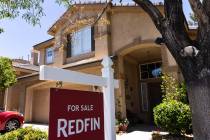Panel tackles Nevada’s home foreclosure crisis
Want to solve the foreclosure crisis in Nevada?
For starters, figure out who holds the actual mortgage notes on delinquent borrowers.
Then enforce state and federal regulations that would prevent the problem from reoccurring.
So said officials and analysts on Tuesday.
Problems determining who holds the actual mortgage note and enforcement of regulations are two reasons that loan modification and foreclosure mediation programs aren't saving people from losing their homes, said David Jones, associate director of Lied Institute for Real Estate Studies at University of Nevada, Las Vegas.
"There are issues because we have banks that not only hold their own mortgages, but they sold off mortgages. It's difficult for the homeowner to work with servicers and investors," Jones said at a public forum sponsored by the Lied Institute.
Jones, who worked for Bank of America and several community banks before joining the UNLV faculty, wanted to know why lenders won't "short-sell" a home back to qualifying owners who occupy the home instead of selling to investors.
Most homeowners in Las Vegas are so far "upside down" on their homes -- owing significantly more than their home is worth -- that they don't qualify for the government's $75 billion Home Affordable Mortgage Plan.
They've asked banks to write down principal mortgage to current values, but only 4.5 percent of those who qualify for the program saw a reduction in principal nationwide, and that figure falls to 1.8 percent in Las Vegas, said Nasser Daneshvary, director of the Lied Institute.
People are worried about short-sale deficiency judgments in which the first-mortgage noteholder has six months to file for judgment and junior lienholders have six years to file.
Mike Clauretie of UNLV's Department of Finance suggested that banks waive the deficiency judgment and write down principal mortgage balances with an agreement that the forgiven share of the loan can be sold off to investors, who would share profits from any future appreciation in the home's value.
That's a possibility when the note is being held and serviced by the same lender, said Joel Sarmiento, senior vice president for Wells Fargo Home Mortgage in Tucson, Ariz. The problem is that 80 percent of loans serviced by Wells Fargo are owned by someone else, predominantly Fannie Mae, Freddie Mac and Ginnie Mae.
"That's a different ballgame. When we own the property, we can do a lot of different things, but when it comes to investors, we don't have the ability to make those decisions," Sarmiento said.
The Home Affordable Mortgage Plan didn't work in Las Vegas because of the city's unique housing situation, said Barbara Buckley, former state Assembly speaker who authored the law in the 2009 Legislature that created the foreclosure mediation program.
People who paid $400,000 for a home that's now worth $130,000 either need a principal mortgage reduction or they're going to make a financial decision to walk away, she said.
"So the first thing we need is more effective government programs specific to Las Vegas," Buckley said. "We're seeing that with the hardest-hit funds. I think the state would be better than the federal government to deal with this."
Buckley praised Attorney General Catherine Cortez Masto for filing a lawsuit against Bank of America over allegations that homeowners were given promises of loan modifications that were not kept.
Bank of America canceled sending a representative to the panel discussion.
There are so many variables to the foreclosure crisis that have created more questions than answers, said Michael Wixom, an attorney specializing in commercial real estate and finance.
Federal regulators have strict loan-to-value requirements for lenders, he noted. On the commercial side, if the loan-to-value doesn't match the appraisal, the bank has to write that loan down.
"We were getting 120 percent loan-to-value when people were buying houses. How did that happen? We need to know that before we can understand the problem ," Wixom said.
Daneshvary of Lied Institute calculated a negative spillover effect of 20 percent to 30 percent decline in value for nondefault homes in neighborhoods with high concentrations of foreclosures.
The tipping point takes place at about 40 foreclosed homes in a neighborhood, he said. That's when homes not in foreclosure sell for about the same as those in foreclosure. Daneshvary found the losses to be about $78,000 on a $292,000 home in a sample neighborhood with 19 homes in foreclosure, factoring in an average time trend discount of 14.8 percent. A total of $366 million is lost on nondefault home values in one year.
Contact reporter Hubble Smith at hsmith@reviewjournal.com or 702-383-0491.























